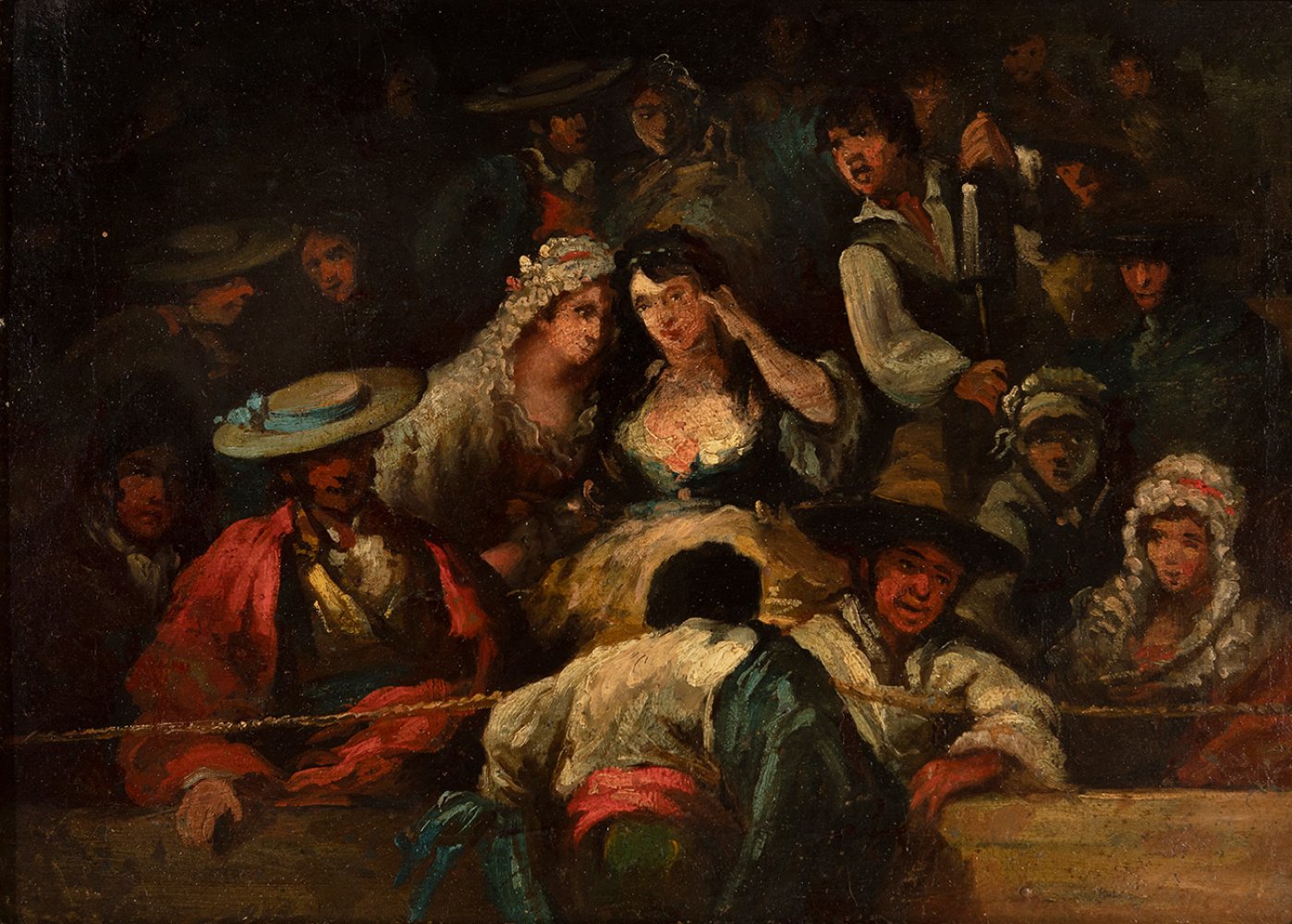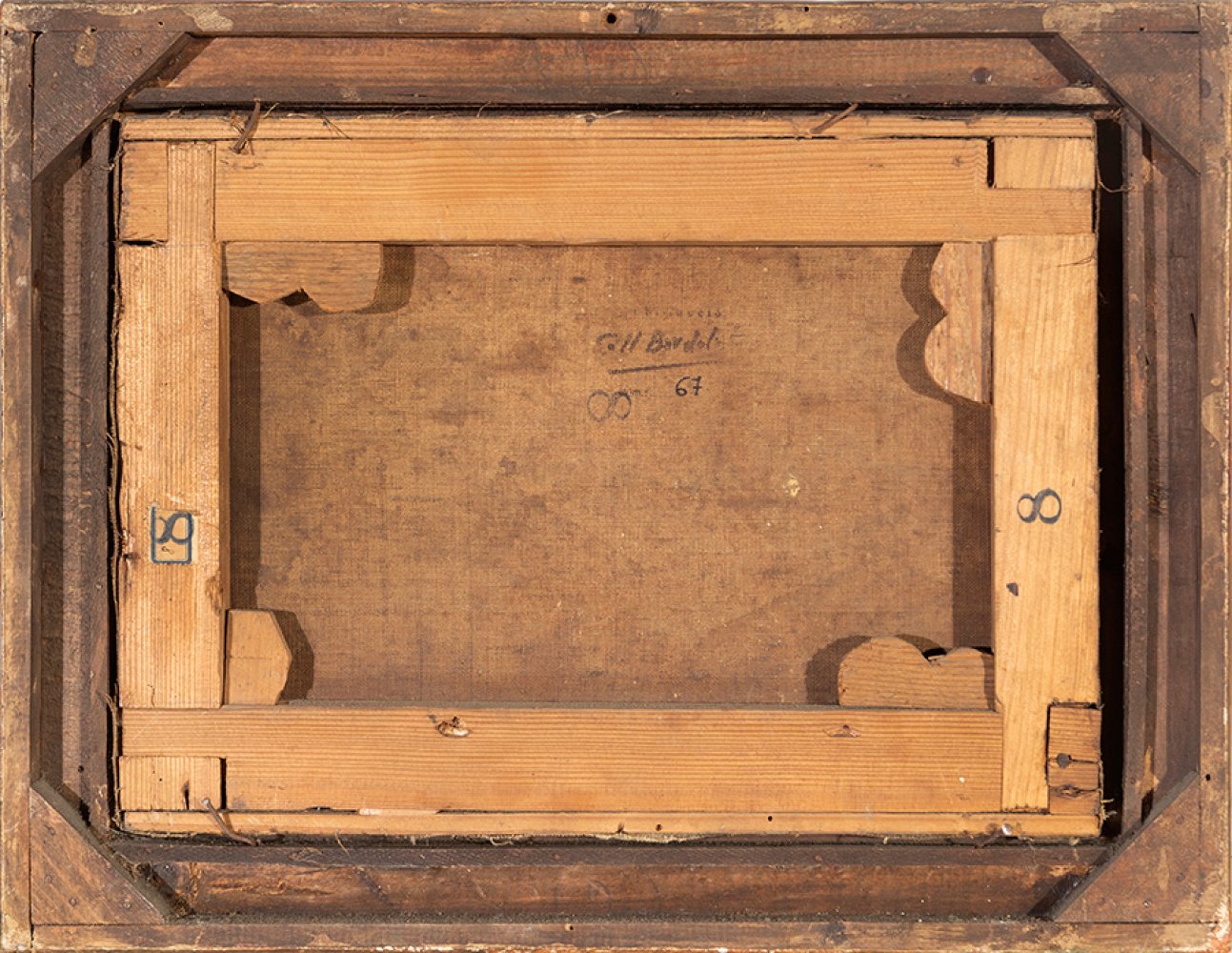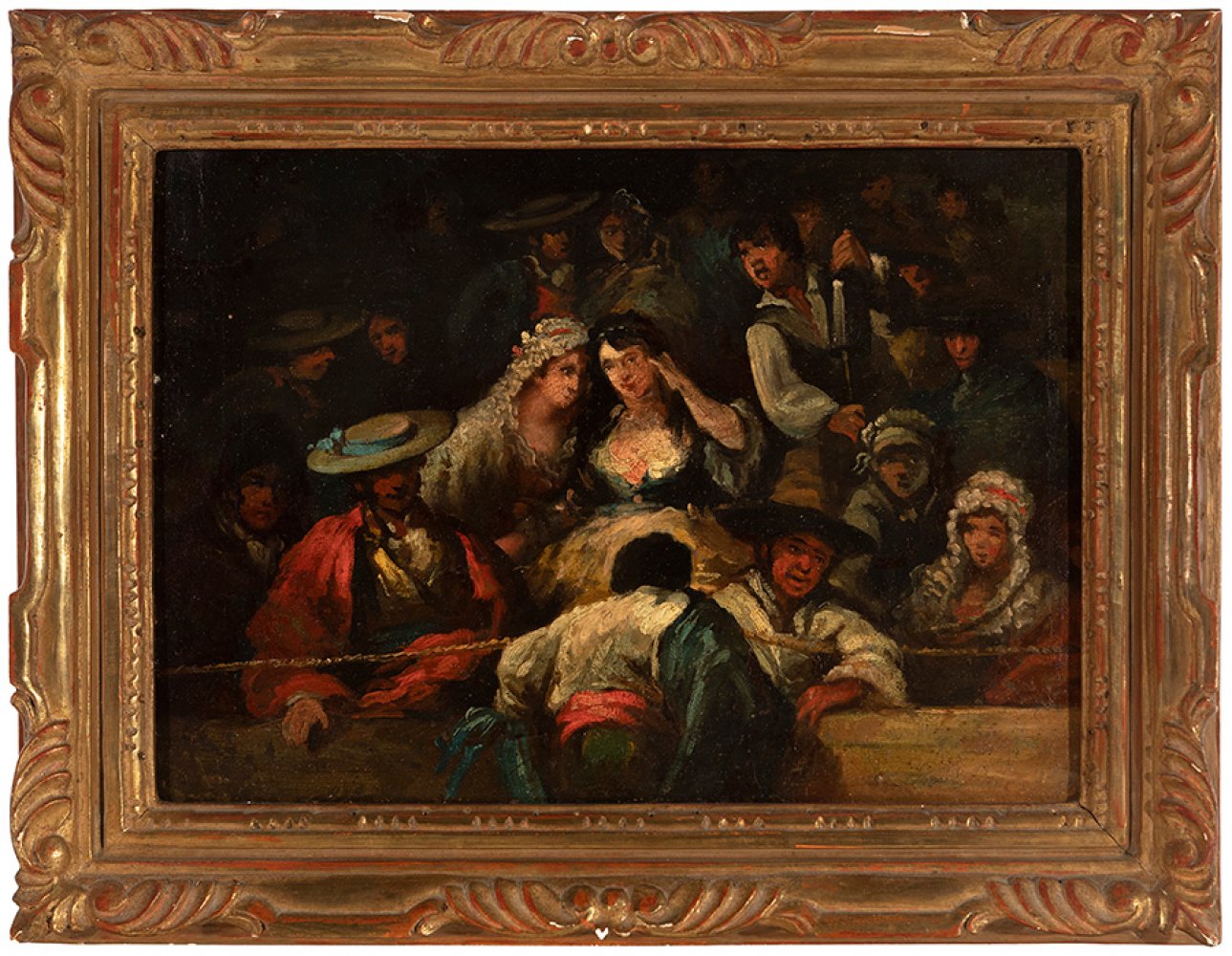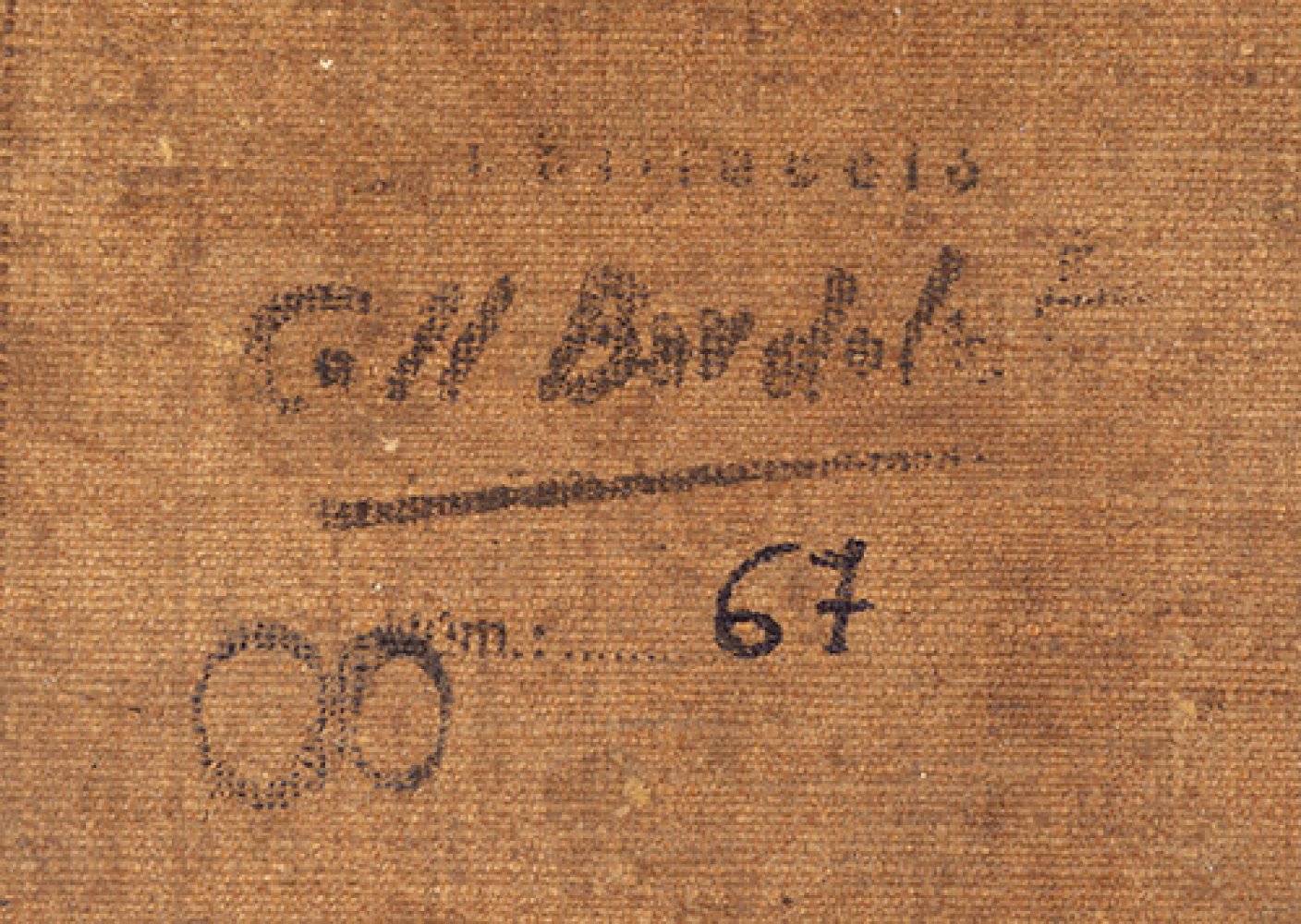60
EUGENIO LUCAS VELÁZQUEZ (Madrid, 1817 - 1870)."In the Bullring".Oil on canvas.With inscription on
"In the Bullring".
Oil on canvas.
With inscription on the back "Coll Bardolet" corresponding to the collection to which it belonged.
Measurements: 25 x 34 cm; 33,5 x 43 cm (frame).
Eugenio Lucas is considered to be the Spanish romantic painter who best understood Goya's art, becoming the most important and passionate follower of the Goyaesque universe after the death of the brilliant Aragonese painter, whose essence he managed to assimilate to the point of making it difficult on certain occasions to correctly attribute some of his works. On this occasion he offers us a scene with a clearly Goyaesque heritage, featuring a couple of majas watching the bullfighting spectacle from the stands of the bullring. The bullfighter seems to be heading towards them as he jumps over the bullring, causing the young women to blush and whisper. The rest of the spectators watching the scene (men in Cordoban hats and women in mantillas) allow us to frame this work within the Spanish regionalist trend, still firmly anchored in Romanticism, where the vindication of the Spanish is not limited to the subject matter but also affects the technical aspect. Thus, we see an impastoed and undone workmanship, rich in material and also in detail, which reflects the brightness of the canvases in the same way as Diego Velázquez did, a great reference point together with Francisco de Goya for a nineteenth-century Spanish school which rediscovered the modernity of its old masters.
Mentioned since the 19th century as Eugenio Lucas Padilla, or Eugenio Lucas the Elder, he was the Spanish Romantic artist who best understood Goya's art. Trained in Neoclassicism at the San Fernando Academy, he soon turned his training around and devoted himself to studying Velázquez and, above all, Goya, whose works he admired and copied in the Prado Museum. In Goya's painting, Lucas Velázquez found the starting point for developing his own imaginative personal painting of fantastic visions and unleashed passions, in the purest Romantic style. He also took his subject matter from Goya and painted scenes of the Inquisition, witches' Sabbaths, pilgrimages and bullfights. In 1850 he also painted the ceiling of the Teatro Real in Madrid, which no longer exists, and later he was appointed honorary chamber painter and knight of the order of Charles III by Queen Isabella II. As a true Romantic, he made several trips, including stays in Italy, Morocco and Paris. His works are characterised by the use of a spirited brushstroke and an unhurried execution, without any concern for drawing, with a dense, impastoed material of great chromatic richness and the presence of strong chiaroscuro. He achieved great success as a genre painter and as a painter of fantastic and sinister scenes, although he was also an excellent landscape and portrait painter. His work is well represented in the Prado Museum, and also in other centres such as the Bilbao Fine Arts Museum, the National Art Museum of Catalonia, the Lázaro Galdiano Museum, the British Museum, the Metropolitan Museum in New York and the Goya Museum in Castres (France).
"In the Bullring".
Oil on canvas.
With inscription on the back "Coll Bardolet" corresponding to the collection to which it belonged.
Measurements: 25 x 34 cm; 33,5 x 43 cm (frame).
Eugenio Lucas is considered to be the Spanish romantic painter who best understood Goya's art, becoming the most important and passionate follower of the Goyaesque universe after the death of the brilliant Aragonese painter, whose essence he managed to assimilate to the point of making it difficult on certain occasions to correctly attribute some of his works. On this occasion he offers us a scene with a clearly Goyaesque heritage, featuring a couple of majas watching the bullfighting spectacle from the stands of the bullring. The bullfighter seems to be heading towards them as he jumps over the bullring, causing the young women to blush and whisper. The rest of the spectators watching the scene (men in Cordoban hats and women in mantillas) allow us to frame this work within the Spanish regionalist trend, still firmly anchored in Romanticism, where the vindication of the Spanish is not limited to the subject matter but also affects the technical aspect. Thus, we see an impastoed and undone workmanship, rich in material and also in detail, which reflects the brightness of the canvases in the same way as Diego Velázquez did, a great reference point together with Francisco de Goya for a nineteenth-century Spanish school which rediscovered the modernity of its old masters.
Mentioned since the 19th century as Eugenio Lucas Padilla, or Eugenio Lucas the Elder, he was the Spanish Romantic artist who best understood Goya's art. Trained in Neoclassicism at the San Fernando Academy, he soon turned his training around and devoted himself to studying Velázquez and, above all, Goya, whose works he admired and copied in the Prado Museum. In Goya's painting, Lucas Velázquez found the starting point for developing his own imaginative personal painting of fantastic visions and unleashed passions, in the purest Romantic style. He also took his subject matter from Goya and painted scenes of the Inquisition, witches' Sabbaths, pilgrimages and bullfights. In 1850 he also painted the ceiling of the Teatro Real in Madrid, which no longer exists, and later he was appointed honorary chamber painter and knight of the order of Charles III by Queen Isabella II. As a true Romantic, he made several trips, including stays in Italy, Morocco and Paris. His works are characterised by the use of a spirited brushstroke and an unhurried execution, without any concern for drawing, with a dense, impastoed material of great chromatic richness and the presence of strong chiaroscuro. He achieved great success as a genre painter and as a painter of fantastic and sinister scenes, although he was also an excellent landscape and portrait painter. His work is well represented in the Prado Museum, and also in other centres such as the Bilbao Fine Arts Museum, the National Art Museum of Catalonia, the Lázaro Galdiano Museum, the British Museum, the Metropolitan Museum in New York and the Goya Museum in Castres (France).
6th October - 19th & 20th Century Art
Sale Date(s)
Venue Address
General delivery information available from the auctioneer
Setdart offers Worldwide shipping
PICK UP IN ROOM: You can come and pick up your lots in our offices (Barcelona, Madrid or Valencia). At the moment of the withdrawal, you will be able to accept the current conditions of the lot by means of a document that you will sign.
YOU CAN SEND ANOTHER PERSON TO PICK UP: This person must present a signed authorization that you can find in our web page by accessing from BUY AT SETDART- LOGISTICS-DOWNLOAD AUTHORIZATION DOCUMENT. You can also send an e-mail with the requested data in AUTHORIZATION DOCUMENT to admin@setdart.com
Important Information
25% buyer´s premium
21% buyer´s premium at www.setdart.com
Terms & Conditions
The maximum period to pay the lots is 7 working days. You can pay either via bank transfer or with credit card through our platform www.setdart.com (we only accept VISA or Mastercard).
BUYER´S PREMIUM: 22% Hammer price + 21% VAT from the buyer´s premium
If your piece has more than 100 years, our Ministry of Culture requires an export certificate in order for the piece to leave the country. Note that if the piece goes inside the EU, there is no cost for the export certificate. If the piece goes outside the EU, there is a cost for the export certificate. You can find more information in our Ministry of Culture website: https://www.culturaydeporte.gob.es/en/cultura/patrimonio/exportacionimportacion/exportacion/tasas.html
INQUIRIES: admin@setdart.com
Setdart guides you through the entire process, from the time of award to the day you receive your lot. Our logistics team will be happy to manage your transport, and will advise you on the best shipping method with professionals from the sector used to handling works of art and jewelry.
WE OFFER WORLDWIDE DOOR TO DOOR SHIPPING
PICK UP IN ROOM: You can come and pick up your lots in our offices. At the moment of the withdrawal, you will be able to accept the current conditions of the lot by means of a document that you will sign.
YOU CAN SEND ANOTHER PERSON TO PICK UP: This person must present a signed authorization that you can find in our web page by accessing from BUY AT SETDART-LOGISTICS-DOWNLOAD AUTHORIZATION DOCUMENT. You can also send an e-mail with the requested data in AUTHORIZATION DOCUMENT to admin@setdart.com
SETDART IS NOT RESPONSIBLE FOR THE STATE OF THE PARTS ONCE THEY LEAVE OUR FACILITIES. MRW SHIPMENTS: Once the payment is made, your lot will be packed for shipment, the logistics department will send you an e-mail notifying you of the day it leaves our warehouse, changes of address cannot be made after receiving this e-mail.
INSURANCE INCIDENTS: Coverage for the value of the auction up to 3000 ? per shipment, if the value of the auction is higher, Setdart will send you a quote including the additional insurance. The insurance company WILL NOT BE RESPONSIBLE FOR THE SHIPMENT THAT EXCEEDS THAT AMOUNT AND IS NOT FULLY INSURED. MRW INCIDENTS: Maximum notification 48 hours after receipt, after which the insurance company WILL NOT BE RESPONSIBLE AND NO CLAIMS WILL BE ACCEPTED.
E-MAIL LOGISTICS: logistica@setdart.com
PICK UP YOUR MESSAGES: You can send your own messaging, prior notice via e-mail that your shipment is ready, please note 3 or 4 days in advance. This type of shipment is packaged so Setdart will provide you with a quote.
EXPENSES FOR STORAGE: We inform you that if the purchased lot is not picked up within a month, you will be charged 30€ per week per lot. Setdart Online S.L., owner of the web site "setdart.com", "setdart.net" and "setdart.org", acts as a company of Spanish nationality inscribed in the Volume 36955, sheet 182, page B-293056 of the Mercantile Registry, with registered office at Calle Aragó















